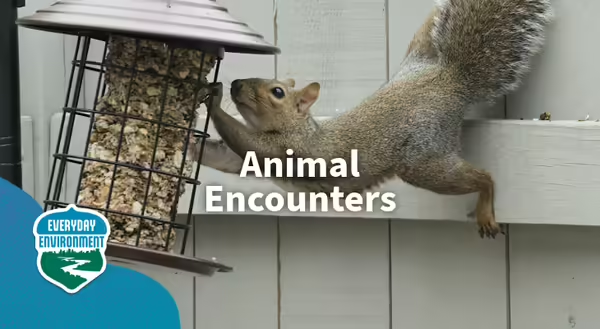
The diversity of forms of wildlife in Illinois is astonishing. There are hundreds of species of fish and birds, and thousands of species of plants and insects. Illinois is home to over 400 species of bees alone!
How do you define wildlife? I think wildlife includes any living organism, which could include any animal, plant, or arthropod, no matter how large its brain or how long its lifespan.
People interact with wildlife daily, even though we may not always recognize that we’re doing so. In farmlands and forested areas, wildlife is often more visible because there are more natural spaces for wildlife to flourish and thus a higher abundance of individuals and species. Here, it may be common to hear a dickcissel singing from a fenceline or to see eastern red bats flitting about at sunset. People flock to remote natural sites to observe phenomena like nesting sandhill cranes in northern Illinois or the annual migration of snakes from the swamp to the cliffs on Snake Road in southern Illinois. Even in urban spaces, like our homes and roadways, many types of wildlife are able to survive and thrive. Raccoons, chickadees, swallowtails, and Joe Pye weed are all common residents of the small parcels of forest and herbaceous plants found in neighborhoods and city parks. They amuse and delight us, and living in a biodiverse environment improves people’s physical and mental health.
Negative wildlife encounters
Not all human-wildlife interactions are positive, however. Many insects, plants, and animals that live alongside us have an array of impacts on people, ranging from irritating to life-threatening. Gray squirrels root in our trash and gnaw on appliances, periodical cicadas emerging from the ground every 13 or 17 years damage young trees in yards and orchards, and poison ivy causes an itchy rash that can be debilitating in some circumstances. While we may not always think favorably of these wildlife taxa, all are native fauna and flora that have been Illinois residents for thousands to millions of years.
But there’s also a host of non-native, invasive species that invaded our state with the aid of humans – via roads, boats, and our own shoes. These organisms just give wildlife a bad name! Urbanites are familiar with the Norway or brown rat that invaded our cities after it was unintentionally brought here on ships from Europe, causing property damage and spreading dangerous bacteria and viruses. While people did intentionally introduce European starlings to the U.S. to invoke a Shakespearean scene, no one foresaw that starlings would be such a threat to our crops, causing millions of dollars in damage annually across the country. The list of invasive plants and insects in Illinois is extensive and still growing as new species come in via ports or even through intentional plantings. Shrubs like bush honeysuckle and autumn olive clog up our forests, preventing regrowth of trees, and poison hemlock forms tall, dense patches in disturbed areas and is poisonous to humans and livestock.
The nature of the nuisance
When we inevitably come into conflict with wildlife, it’s important to consider the provenance of the organism when formulating a strategy for overcoming the issue. It’s also worth considering the nature of the nuisance – is it life-threatening, damaging to valuable property, or just irritating? Solutions can be planned accordingly. Illinois Extension's Wildlife website helps Illinoisians navigate their interactions with wildlife, preventing conflict whenever possible. Our aim is to promote coexistence between humans and wildlife to preserve the rich biodiversity in Illinois so that future generations can reap the same benefits we do today.
Learn more about wildlife
Here's what you can find on the Wildlife website:
- Explore the Learn tab for a map of the distributions of our native wildlife.
- The Encounters tab gives tips to navigate our encounters with wildlife – ranging from everyday encounters that can be quite positive to annoying, risky, or dangerous encounters that require more circumspection.
- The Stewardship tab points readers to positive actions they can take to benefit wildlife in their backyards and natural spaces.
- If you want to get even more involved, through community science projects or by interning or pursuing a degree, check out the Engage tab.
- And listen to the engaging calls of wildlife filed under Voice of the Wild, an Illinois Extension podcast.
Whether you’re watching birds along the lake shore, photographing butterflies on milkweed, or fighting with the squirrels ransacking your birdfeeder, it’s almost certain your interactions with wildlife will heighten your curiosity about the natural world. Observing animal behaviors, habitat associations, and seasonal patterns in nature, we hope you will become more confident in navigating these interactions and coexisting with our abundant and diverse wildlife.
Thank you for reading!
Everyday Environment is a series of blogs, podcasts, webinars, and videos exploring the intricate web of connections that tie us to the natural world. The fall 2025 series explores wildlife in Illinois.
Want to listen to us chat more about wildlife in Illinois? Check out the podcast episode on this topic to hear more from the Everyday Environment team.
Listen to the Podcast Sign Up for Everyday Environment Newsletter